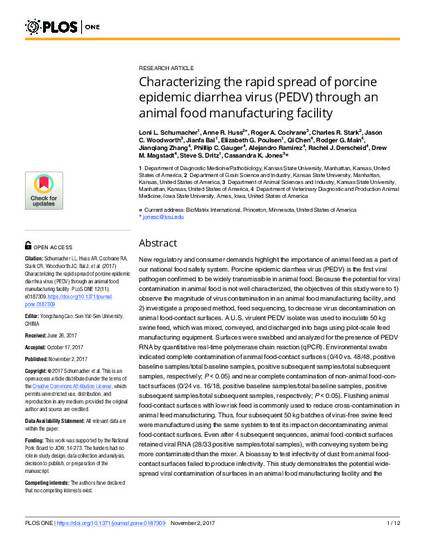
New regulatory and consumer demands highlight the importance of animal feed as a part of our national food safety system. Porcine epidemic diarrhea virus (PEDV) is the first viral pathogen confirmed to be widely transmissible in animal food. Because the potential for viral contamination in animal food is not well characterized, the objectives of this study were to 1) observe the magnitude of virus contamination in an animal food manufacturing facility, and 2) investigate a proposed method, feed sequencing, to decrease virus decontamination on animal food-contact surfaces. A U.S. virulent PEDV isolate was used to inoculate 50 kg swine feed, which was mixed, conveyed, and discharged into bags using pilot-scale feed manufacturing equipment. Surfaces were swabbed and analyzed for the presence of PEDV RNA by quantitative real-time polymerase chain reaction (qPCR). Environmental swabs indicated complete contamination of animal food-contact surfaces (0/40 vs. 48/48, positive baseline samples/total baseline samples, positive subsequent samples/total subsequent samples, respectively; P < 0.05) and near complete contamination of non-animal food-contact surfaces (0/24 vs. 16/18, positive baseline samples/total baseline samples, positive subsequent samples/total subsequent samples, respectively; P < 0.05). Flushing animal food-contact surfaces with low-risk feed is commonly used to reduce cross-contamination in animal feed manufacturing. Thus, four subsequent 50 kg batches of virus-free swine feed were manufactured using the same system to test its impact on decontaminating animal food-contact surfaces. Even after 4 subsequent sequences, animal food-contact surfaces retained viral RNA (28/33 positive samples/total samples), with conveying system being more contaminated than the mixer. A bioassay to test infectivity of dust from animal food-contact surfaces failed to produce infectivity. This study demonstrates the potential widespread viral contamination of surfaces in an animal food manufacturing facility and the difficulty of removing contamination using conventional feed sequencing, which underscores the importance for preventing viruses from entering and contaminating such facilities.
Available at: http://works.bepress.com/alejandro_ramirez/48/

This article is published as Schumacher, Loni L., Anne R. Huss, Roger A. Cochrane, Charles R. Stark, Jason C. Woodworth, Jianfa Bai, Elizabeth G. Poulsen, Qi Chen, Rodger G. Main, Jianqiang Zhang, Phillip C. Gauger, Alejandro Ramirez, Rachel J. Derscheid, Drew M. Magstadt, Steve S. Dritz, and Cassandra K. Jones. "Characterizing the rapid spread of porcine epidemic diarrhea virus (PEDV) through an animal food manufacturing facility." PloS ONE 12, no. 11 (2017): e0187309. DOI: 10.1371/journal.pone.0187309. Posted with permission.